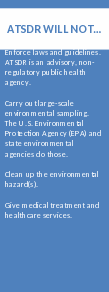Community Meeting Fact Sheet
AttD Communty Mtng Fact Sheet 20201130.docx
ATSDR Communication Activities Survey (ACAS)
Community Meeting Fact Sheet
OMB: 0923-0055
ATTACHMENT D. Community Meeting Fact Sheet
 ATSDR
Site Activities and the ATSDR Communication Activity Survey (ACAS)
ATSDR
Site Activities and the ATSDR Communication Activity Survey (ACAS)
What is ATSDR?
ATSDR (Agency for Toxic Substances and Disease Registry) is a federal public health agency responsible for evaluating human health effects caused by exposure to hazardous substances. ATSDR was created by Congress in 1980 as a result of the Superfund law. The purpose of the law was to protect the public from hazardous wastes and environmental spills of hazardous substances. Its mission is to serve the public by using the best science, taking responsive public health actions, and providing trusted health information to prevent harmful exposures and disease related to toxic substances.
Why are we here?
The purpose of this meeting is to explain the results of ATSDR’s findings and collect feedback from the community on how well ATSDR provided you with the (communicated) information you need to reduce your risk to hazardous substances.
What does ATSDR do?
ATSDR conducts a number of activities in communities to help prevent or reduce the harmful health effects of exposure to hazardous substances. ATSDR may have conducted one or more of the following activities in your community.
Public health reports
ATSDR finds communities where people might be exposed to hazardous substances in the environment and decides how unsafe a site is and recommends actions that need to be taken to protect people’s health. ATSDR prepares written/oral reports called Public Health Assessments (PHAs) or Health Consultations (HCs) in response to requests for information about health risks at specific sites or hazardous substances. PHAs and HCs are written to prevent exposures and may lead to actions that limit the use of water supplies, increase environmental sampling, limit site access, or get rid of contaminated substances.
Health education
ATSDR develops and distributes materials on the health effects of exposure to hazardous substances to communities, doctors, and other healthcare providers to educate them on ways to prevent exposure.
Health studies
ATSDR studies communities near hazardous waste sites to see if people’s health has been affected by their exposure to hazardous substances and also fund research led by universities, state agencies and others who study the link between exposure to hazardous substances and disease.
Research
 ATSDR
conducts or sponsors research to increase scientific knowledge about
health effects of hazardous substances in the environment.
ATSDR
conducts or sponsors research to increase scientific knowledge about
health effects of hazardous substances in the environment.
Disease and exposure registries
ATSDR maintains national registries of persons exposed to hazardous substances in the environment. For example, ATSDR manages its Tremolite Asbestos Registry and its National Amyotrophic Lateral Sclerosis (ALS, or Lou Gehrig ’s disease) Registry. For disease registries, people with health conditions are watched for differences in their chemical exposures compared to national norms. For exposure registries, people with chemical exposures are watched for differences in their health conditions compared to national norms.
Toxicological profiles
ATSDR publishes detailed information on health effects of many harmful substances, finds gaps in knowledge, and researches toxicology and health effects, in its Toxicological Profiles. In addition, the agency publishes 2-page summaries of the profile information called ToxFAQs. In these easy-to-understand fact sheets, communities can find answers to questions asked most about exposures to hazardous substances and health effects.
Emergency response
ATSDR provides technical support and advice to federal agencies, states, local agencies, and healthcare providers on how to improve response to public health emergencies related to exposures to hazardous substances like fires and accidental spills from train wrecks.
Emergency surveillance
Since 1990, ATSDR has managed a state-based surveillance system that collects data on spills and releases of hazardous substances. The purpose of the surveillance system is to collect and analyze information about acute releases of hazardous substances, describe the public health effects related to the release of toxic substances, and to help reduce and stop releases of these substances and the injuries and deaths that could result.
How can you help us? We need your feedback.
ATSDR is conducting a survey, called the “ATSDR Communication Activity Survey (ACAS),” to find out how helpful we were in addressing your questions and health concerns through the above listed activities. This information will help us to improve the timeliness and responsiveness of our services to the community. We value your feedback. If you are interested, please take a few minutes to complete the brief survey after the meeting. It should take you about 15 minutes to finish.
ATSDR is also testing a short three-minute cell phone survey called the “SMS Text Survey.” We are interested to see if this type of survey will work to collect responses from community members and stakeholders.
CONSENT: First, if you are interested in taking part, we will ask you to sign in. Providing your contact information and taking part in the ACAS or the SMS Text Survey is completely voluntary. You may skip any question or stop at any time. Your responses and identity will be kept private to the extent allowed by law. Digital data will be stored in secure computer files. We will not release your identity in any ATSDR reports. Please be sure to get all of your questions about the survey answered by ATSDR before you begin. By the SMS Text Survey, you agree to accept all text message charges, if applicable. By proceeding, you indicate that you are 18 years of age or older, and CONSENT to participate in the ACAS or the SMS Text Survey. Thank you for providing your information!
| File Type | application/vnd.openxmlformats-officedocument.wordprocessingml.document |
| Author | Smith-George, Januett P. (ATSDR/DCHI/OD) |
| File Modified | 0000-00-00 |
| File Created | 2021-01-12 |
© 2025 OMB.report | Privacy Policy